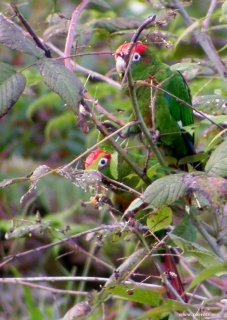Rose-crowned Conure |
|
|
Also known as: Rose-crowned Parakeet, Rose-headed Conure or Parakeet
Photos
View in GalleryDid You Know?
The bright red cap and white primary coverts distinguish the Rose-crowned Conure from all other small long-tailed South American parrots.Academic Research
Related publications: Pyrrhura rhodocephalaSpecies Profile
Genus: Pyrrhura | Species: rhodocephala
Size:
24cm (9.3 in)
Weight:
Not recorded.
Subspecies including nominate:
one
Colour Adult:
Both adults mainly green in colour; rose/red forehead to occiput; maroon ear coverts; orange/yellow carpal edge with white tint; white primary coverts. Tail brown/red. Bill horn in colour. Eye ring bare and white. Eye brown.
Colour Juvenile:
Green crown with dull blue tinge, with scattered red feathers; blue primary coverts.
Call:
Calls made in flight softer and less harsh than those of most Pyrrhura species. Calls made while perched are clear and sharp, or rapidly repeated staccato notes.
Listen NowVideo Links:
Video 1More Information:
Content Sources:
CITES
BirdLife International
Cornell Lab of Ornithology/Birds of the World
A Guide to Parrots of the World, Juniper and Parr, 1998
ML Media Collection Catalogue 68607, Rose-crowned Parakeet Pyrrhura rhodocephala, Schwartz, Paul, Merida, Venezuela, April 1970, Cornell Lab of Ornithology. Site
Parrots of the World, Forshaw, 2006. 2010 edition
Parrots in Aviculture, Low, 1992.
Photos
View in GalleryDid You Know?
The bright red cap and white primary coverts distinguish the Rose-crowned Conure from all other small long-tailed South American parrots.Academic Research
Related publications: Pyrrhura rhodocephalaSpecies Care
Captive Status:
Uncommon
Longevity:
Probably 10-15 yrs.
Housing:
Aviary with shelter 3 x 1 x 2m (9.8 x 3.3 x 6.5 ft).
Diet:
Fruit such as: apple, pear, orange, banana, pomegranate, cactus fruits, kiwi, forming about 30 percent of the diet; vegetables such as: carrot, celery, green beans and peas in the pod; fresh corn on the cob; green leaves such as: Swiss chard, lettuce, sowthistle, dandelion, chickweed; spray millet; small seed mix such as: canary, millet and smaller amounts of oats, buckwheat, safflower and a little hemp; soaked and sprouted sunflower seed; cooked beans and pulses, boiled maize and complete pellet.
Enrichment:
Avid chewer so provide bird-safe, unsprayed flowering, fir, pine, willow and elder branches, heat sterilized pine cones, wooden block and vegetable tanned leather toys; swings, ropes, and ladders.
Nest Box Size:
Vertical box 8" x 8" x 24" (20.3cm x 20.3cm x 61cm).
Clutch Size:
4-6
Incubation Time:
Probably 23-24 days.
Fledging Age:
Probably 7-8 weeks.
Hatch Weight:
Probably 5g (0.2 oz).
Peak Weight:
Not recorded.
Weaning Weight:
Not recorded.
Photos
View in GalleryDid You Know?
The bright red cap and white primary coverts distinguish the Rose-crowned Conure from all other small long-tailed South American parrots.Academic Research
Related publications: Pyrrhura rhodocephalaSpecies Wild Status
World Population:
Unknown, stable.
IUCN Red List Status:
Least Concern
CITES Listing:
Appendix II
Threat Summary:
Not globally threatened. Restricted-range species: present in Cordillera de Mérida Endemic Bird Area. Fairly common within its limited range. Some habitat loss has occurred but is not yet a problem. Little trade recorded.
Range:
NW Venezuela.
Habitat:
Found from 1500-2500m (4920-8200 ft) in the subtropical zone in montane humid forest and elfin woodland, including secondary growth areas and partly cleared forest, forest edge and páramo.
Wild Diet:
Probably berries, seeds, fruits and flowers.
Ecology and Behaviour:
Gregarious; generally seen in flocks of 10-30 birds outside breeding season. Larger groups gather in communal roost at night. Generally quieter than other Pyrrhura species.
Clutch and Egg Size:
Probably 4-6 eggs.
Breeding Season:
April-June.
Photos
View in GalleryDid You Know?
The bright red cap and white primary coverts distinguish the Rose-crowned Conure from all other small long-tailed South American parrots.Academic Research
Related publications: Pyrrhura rhodocephalaMembers Only Resources
Please log-in now to find more research, resources and tools.
Not a Member?
Find more great information:
Gain exclusive access to 600+ pages of additional research, seminars and podcasts, specialists to ask your toughest questions, and dozens of other fun resources - when you become a WPT member.
Join Today >>

































